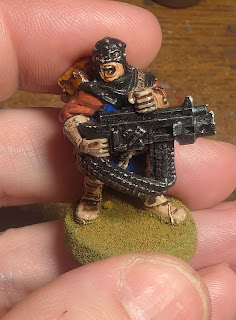Lately, almost all of my hobby time has been devoted towards my 10mm Macedonian Successor army for To The Strongest.
Having pushed through phalangite, hypaspists, hoplites, skirmishers and command...I only have a few more cavalry and elephant units to finish up.
Sure there are more hoplites to complete but they are more for mercenaries to be used with the Persian and other armies.
Having a brief free moment, I snapped some pictures of the progress and now I can share them with you.
First up, we have the backbone of the army, six bases of phalangites. These fellas were serve as both hammer and anvil for most tabletop battle scenarios. I painted each base in its own scheme and I like the finished look. I won't go into too much detail because I've already spoken on these sculpts here, but I will say this as a tangent....I have a bad habit of butchering the pronunciation of ancient (maybe all) words. For decades, I pronounced these guys as " Fal-anj-ites" and recently I heard someone pronounce them as "Fal-an-geet-eez". I have no doubt I am wrong and they are right.


Next up we have two hypaspist units. I know there are different interpretation of this troop type. Old Glory have them sculpted as javelin/spear armed and they will be classified as javelinmen in my TTS armies. I added Macedonian sun burst designs on their shields, these are transfers from Veni Vidi Vici and are rather nice. To ensure I had enough transfers, I cut them in half and only used the half transfer on the portion of the shield that is visible.
Here are our Greek mercenary hoplites (again I pronounce "hop-lights" and I'm sure it is "Hop-leet-eez"). I enjoyed painting these sculpts even if they are time consuming. I painted them up as individuals instead as uniformed soldiers of the state. No uniformity whatsoever. I used more transfers from VVV and they went on like a charm. I opted for a longer spear but still shorter than a pike.
The army has three sling and two bow armed skirmisher bases. Old Glory sculpt their slingers on 2 figure bases while the bowmen are individual. Painted plain but the bowmen have red headbands.
And here are two units of cavalry, companions (yellow and purple) and Thessalians (blue and white). Need to paint up a couple more bases of these cavalry types. Like the phalangites and hoplites, the Macedonian cavalry require you to drill holes out of the hands and insert wire for spears. Much easier than it sounds like it would be.
Nothing says Successors like pike and elephants. You saw the pike already and here are the elephants. Or rather elephant. I have more painted up but this is the only one bases right now. In TTS, these bases will represent "elephant screens" and will be less shock than pachyderms represent in other army lists. I plan to paint up a total of six of these bases.
And lastly, we have some Macedonian/Successor command. I plan to have a couple mounted sub-commanders, a couple foot sub-commanders and a generic overall leader.
I should add that almost all of the figures are Old Glory, the bases are Litko and the elephants and riders are 10th Legion (formerly Magister Militum).
With two bases of cavalry, a few more elephant units and a command base left to paint....I'm not sure what I will to next. Should I paint up 10mm Persians and Indians to face off against Macedonians (and each other)? Should I venture back into my 6mm Tercios late 17th century armies (Jacobites, English, Scanian Wars, etc) or should I finish off my 10mm Fenian project?




































